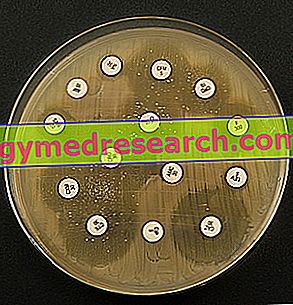What are Antibiotics?
Antibiotics are substances processed by living organisms or produced in the laboratory, capable of determining the death of bacteria or preventing their growth.

Antibiogram: each disk is soaked in a different antibiotic; where the dark halo is missing means that the antibiotic is effective in killing the bacterium disseminated in the culture medium.
DIFFERENCE BETWEEN ANTIBIOTICS AND CHEMOTHERAPIES
Both are antibacterial drugs. The difference, originally, was based on the fact that chemotherapeutic drugs are synthetic drugs, while antibiotics have a natural origin; the latter originate, for example, from the metabolism of fungi (molds) or from that of certain bacteria (streptomycetes).
Antibiotics represent a constantly evolving pharmaceutical category, so many natural molecules have been chemically modified to obtain new drugs, called semisynthesis.
Functional classification
Depending on the effects on the microorganism, the antibacterials are divided into:
- BACTERIOSTATIC ANTIBIOTICS: block the growth of the bacterium, facilitating its elimination by the body.
- ANTIBIOTICS BACTERICIDES: which determine the death of the bacterium.
bactericides | bacteriostatic | |
Aminoglycosides betalactams Quinolones cycloserine cotrimoxazole daptomycin Fosfomycin glycopeptides Isoniazid nitroimidazoles pyrazinamide Polypeptides Rifamycines streptogramins | Fusidic acid amphenicols Dapsone Ethambutol lincosamides Macrolides nitrofurans novobiocin sulfones sulfa Tetracycline | |
Many times bacteriostatic or bactericidal activity depends on the dosage of intake.
On the basis of the action spectrum we talk about:
- ANTIBIOTICS WITH BROAD RANGE: active against both gram-positive and gram-negative bacteria.
- ANTIBIOTICS WITH RESTRICTED SPECTRUM: they act only on certain bacteria.
Synergism and Antagonism
- CONCEPT OF SYNERGISM: two antibiotics increase their activity when they are used together; in fact, they act on two different targets. The former, for example, inhibits protein synthesis, while the latter inhibits nucleic acids.
- CONCEPT OF ANTAGONISM: the activity of two antibiotics influences each other, as when they both act on the same biological target.
Combinations of multiple antibiotics can be used to treat polymicrobial infections, to prevent the appearance of resistant microorganisms, or to achieve a synergistic effect. For example, multi-therapy is used in the treatment of AIDS and for micro-organisms that have frequent mutations.
Chemotherapy
They are drugs that act as antimetabolites and compete for the substrate with the enzyme that catalyses a certain reaction.
SULPHAMIDS : they act by inhibiting the synthesis of folates, indispensable substrates for the formation of nucleotides and amino acids. Man takes on folates through diet, while bacteria synthesize them from precursors (because the bacterial wall is impermeable to these substances). Thanks to this assumption, sulfa drugs are toxic to the bacterium, but not to humans. The only microbe that escapes the action of these antibiotics is the intestinal enterococcus, which manages to absorb folic acid from the enteric kilo.
Sulfonamides have a structure similar to para-amino benzoic acid (a substrate necessary for the bacterial synthesis of folates) and compete with it for the relative enzyme (to which they bind by sequestering it).
TRIMETHOPRIM : extremely widespread chemotherapy. It inhibits the bacterial production of folates, but, in the series of biochemical steps that lead to their synthesis, it acts at a different level compared to sulfonamides.
CHINOLONS : chemotherapy derived from nalidixic acid. They act by inhibiting topoisomerase II; this protein, also known as gyrase, is formed by 2 subunits, A and B, which allow the unwinding and rewinding of bacterial DNA. The sub unit A cuts the DNA into specific sites, while the B acts in the so-called negative spiralization (DNA winding). Quinolones act by inhibiting the subunit A of gyrase and with it the replication of bacterial DNA ( novobiacin is active on the B subunit and can therefore have a synergistic action with quinolones).
Categories of antibiotics
Antibiotics can be distinguished on the basis of their biological target, therefore on the ability to:
- inhibit cell wall synthesis (penicillins and cephalosporins)
- disrupt the lipid structure of the cell wall (polymyxins)
- inhibit protein synthesis by acting on the minor subunit (30s) of the ribosome (such as tetracycline and aminoglycosides, including gentamicin) or on the major one (50s), such as chloramphenicol and macrolides.
- inhibit the synthesis of nucleic acids by acting on DNA duplication (novobiocin) or on its transcription in RNA (rifamycins).



